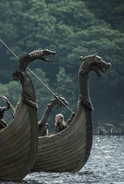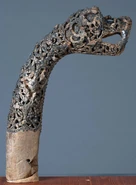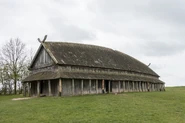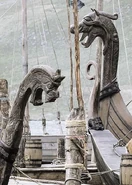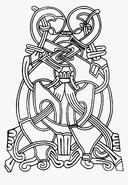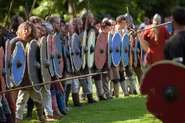Vikings were 8-11th century Norse seafarers from Southern Scandinavia. They hold a prominant part of pop culture with common (yet innacurate) caricatures, one example of which being the horned helmet.
The aesthetic is characterized by the Northern regions that the Vikings came from, along with many visuals of boats and sea travel. Unlike the similar Northerness aesthetic, there is more of a focus on coastlines versus woodlands. Additionally, the Viking aesthetic is more rooted in the history of the group, whereas the Northerness aesthetic is more focused on the mythology and pagan elements of the area.
Visuals[]
Vikings, being seafarers, are well known for their boatmaking skills. In pop culture they often sported a dragon figurehead. Viking longboats are thin and shallow, designed for speed. They have square sails and are used with oars.
While in battle vikings use round shields, and for weapons they use spears, a sword or battle axe, or bows.
Viking art is often in the form of intricate carvings found on a number of their possesions, including household objects, weapons, furniture, and buildings. Common motifs in Viking art are animals and organic sinuous forms, and later on they may feature runes. There are six viking art styles each from a different time period.
The six styles are:
- Oseberg (780-850ad). Seen on the Oseberg ship burial and most recognised for its “gripping beast” motifs.
- Borre (840 to 970ad) named after the bronze bridle mounts discovered in Borre, near Vestfold, Norway. Like Oseberg but the head of the creatures are more prominent and feature interlacing chains, such as in Gaut’s Cross from the Isle of Man. This style is related to Celtic knots.
- Jelling (10th century) difficult to identify, but often features “ribbon-like” intertwined S-shaped beast forms with billets.
- Mammen (10th century denmark) named after Mammen Axe, it is similar to jelling but has more animl motifs and is filled with pelleting
- Ringerike (early 11th century) mostly on stone carvings, and unusually feature more plant motifs than earlier styles.
- Urnes (11th to mid 12th century) more intricate knotted bodies of beasts and snakes, named after Urnes Stave Church in Norway.
Fashion[]
Their clothing would be warm, made of linen and wools. With the natural dyes available and how they traveled and traded with many places, it is likely they had access to a full rainbow of colours. Women wore strap dresses with a smock underneath. The straps may be attached by brooches with strings of beads between them. Men wore a tunic and trousers. Both would wear capes for warmth, and leather shoes.
History[]
The Vikings were a seafaring group of people originating from Scandinavia in the 8th to 11th centuries. Unlike other Scandinavians peoples, they were notable for the fact that they travelled extensively, rather than settling in one place. It has been confirmed that Vikings travelled everywhere from Europe to Africa to the Middle East and even to North America. They established trade routes throughout these regions, and sometimes built settlements. The language of the Vikings was mainly Old Norse, and the main religion was Old Norse (although many Vikings converted to Christianity starting in the 10th century).
Controversy[]
The aesthetic has unfortunately been misappropriated by white supremacists and warped to fit their values. Vikings, unlike the imagined version, were a multicultural and multiethnic collection of societies. As well as this, viking women at that time had a considerable amount of freedom.
There are also a number of misconceptions surrounding the group, including the idea that they wore horned helmets and dreadlocks. Contrasting historical accounts describe vikings both as 'Filthiest of all Allah's creatures' (Ibn Fadlan) or "in the habit of combing their hair every day, to bathe every Saturday, to change clothes frequently" (John of Wallingford). The latter is supported by their combs, often with intricate carvings and placed in their burial sites, and that they had bathhouses and saunas. However this may just place them higher on the cleanliness scale than Anglo-saxons, but not as clean as 10th century Muslims.
Media[]
Literature[]
- Beowulf
- The Iceland Sagas
- The Ring of Nibelung
- Dragonships series
TV/Movies[]
- Norsemen
- Vikings
- How to Train Your Dragon series
- Thor series
- Valhalla Rising (2009)
- The Northman (2022)

